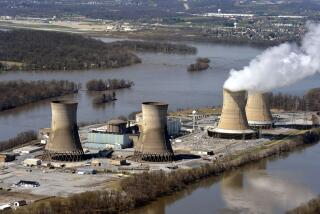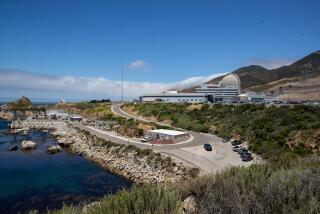Savannah Nuclear Site Cleared to Resume Production : Weapons: The reactor produces tritium, a vital material for warheads. Environmentalists and safety critics bitterly oppose the restart.
WASHINGTON — Nearly four years after it was shut down amid acute concern over its safety, a government nuclear reactor that makes vital material for thermonuclear warheads was given a much-debated clearance Friday to begin preparations to resume production.
With a go-ahead from Energy Secretary James D. Watkins, Westinghouse Electric Corp., operator of the government’s Savannah River nuclear weapons site, almost immediately put into motion a weekslong restart process leading toward resumption of tritium production by the 37-year-old “K” reactor.
In the course of the shutdown, the plant has undergone nearly $1 billion in safety and modernization improvements.
Nevertheless, resumed operations by the reactor have been bitterly opposed by environmentalists, by safety critics and by others who insist that the collapse of the Soviet Union and the dismantling of thousands of nuclear weapons make operation of the plant unnecessary.
Watkins’ authorization to begin the restart process came after environmentalists lost a court bid to delay restart until completion of an $80-million cooling tower to prevent the release of hot water into the Savannah River.
“My action culminates several years of intense effort to assure that the reactor can be brought back on line safely,” he said in a memorandum giving the go-ahead to Richard A. Claytor, chief of the Energy Department’s defense programs. “At your discretion, you should direct the manager of the Savannah River field office to restart K reactor.”
In spite of the virtual disappearance of the Soviet Union and the shrinkage of both Eastern and Western nuclear arsenals, the Bush Administration has insisted it was necessary to return the reactor to operation to provide the United States a continuing supply of tritium.
The radioactive gas boosts the power of thermonuclear weapons, but it is lost through radioactive decay at the rate of about 5% per year and must be systematically replenished.
Critics of the restart contend that the tritium requirements for the foreseeable future could be met by “mining” the warheads being taken out of service, and using their tritium supplies to replenish those remaining in the active strategic weapons inventory.
By some estimates, the tritium taken from decommissioned weapons could provide sufficient supplies for the remainder of the decade.
Watkins’ authorization set in motion a long series of final tests of emergency safety equipment, to be followed by a test of control rods, and finally their withdrawal, initiating a nuclear chain reaction.
According to Energy Department officials, future operations will see the reactor run at only about one-third of its maximum power in order to minimize the chance of a mishap.
Before reaching its planned operational power level, the plant will be briefly shut down again while new, more heat-resistant safety rods are installed.
The go-ahead issued Friday came following the surmounting of nagging technical obstacles in addition to political and environmental opposition. The restart represented a rare personal triumph for Watkins, whose tenure at the Energy Department has been marked by a series of frustrations in his efforts to clean up and modernize the country’s polluted and outmoded nuclear weapons sites.
Along with the testing of a permanent depository for radioactive waste from weapons labs, now blocked by court order, he had placed the restart of the K reactor among the top objectives at the Energy Department.
In spite of the huge outlay on safety improvements and plans to operate at reduced power in the future, safety critics insist that the reactor’s age and design make its operation unacceptable.
Robert Cornog, who co-discovered tritium and now is a consultant to Bridge the Gap, a Los Angeles-based watchdog group, last week characterized the restart as “a game of Russian roulette on a grand scale.”
In a statement submitted to the Defense Nuclear Safety Board before it gave Watkins its restart approval earlier this week, Cornog warned that despite the modifications, the reactor has hazards irreversibly incorporated in its design.
“For example,” he said, “it lacks the thick strong containment structure that has been required of all of the electric power reactors now operating in the United States.”
In addition to the safety and environmental concerns, the restart of the reactor encountered opposition from powerful members of Congress, who favored spending the money instead on a new production reactor, estimated to cost $6 billion. But insisting on the urgency of regaining a source of tritium, Watkins opted to press ahead with restart of the K reactor while delaying a design selection for the new reactor by two years.
After the Chernobyl reactor accident in the Soviet Union in 1986, the National Academy of Sciences conducted a study of K reactor and concluded that its emergency core cooling system was too small.
It continued to operate until 1988, however. Then it was closed down, along with the similar “L” and “P” reactors, when it experienced a restart problem, which was not understood. Subsequent studies showed that persistent efforts to restart it could have led to a serious accident.
More to Read
Sign up for Essential California
The most important California stories and recommendations in your inbox every morning.
You may occasionally receive promotional content from the Los Angeles Times.










